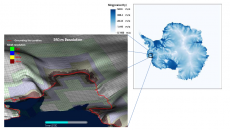BISICLES for Ice Sheet in Climate applications

Schematic showing computed ice velocity for Antarctica (right), and (left) meshing and grounding line location for the Pine Island Glacier.
Recent observations show that the Greenland and Antarctic ice sheets are losing mass at increasing rates. If recent trends continue, ice sheets will make a dominant contribution to the 21st century sea-level rise (SLR), far exceeding the projections of the IPCC's Fourth Assessment Report, AR4. Growing ice mass losses not only could raise sea level, but also could affect other parts of the climate system, such as the Atlantic Meridional Overturning Circulation and its associated poleward heat transport, through increased freshwater discharge to high-latitude oceans.
The dynamics of ice sheets span a wide range of scales. Correctly resolving the dynamics of localized regions, such as grounding lines and ice stream shear margins, requires extremely fine resolution (better than 1 km in places). In particular, resolving the dynamics of the grounding line (where the land-based ice sheet meets the ocean and begins to float) is critical to understanding the dynamics of the ice sheet. Modeling an entire continental-scale ice sheet at such resolutions is impractical or impossible with current computational resources. At the same time, such fine resolution is unnecessary over large dynamically quiescent regions, which makes ice sheet modeling an ideal candidate for adaptive mesh refinement (AMR).
BISICLES is a scalable AMR ice sheet modeling code built on the Chombo framework and is a part of the Community Ice Sheet Model (CISM). With a dynamical core based on the vertically-integrated model of Schoof and Hindmarsh (2011), BISICLES can resolve dynamically important regions at the sub-kilometer scale while using much coarser resolution where appropriate. BISICLES is currently a part of the ProSPect ASCR-BER SciDAC4 partnership, and was a part of the PISCEES (Predicting Ice Sheet and Climate Evolution at Extreme Scales) ASCR-BER Scidac3 Applications Partnership.
ANAG Members
- Daniel Martin (lead)
- Peter Schwartz
Collaborators
- Esmond Ng (LBNL)
- Sam Williams (LBNL)
- Stephen Cornford (University of Swansea)
- Antony Payne, Victoria Lee (University of Bristol)
- Stephen Price (Los Alamos National Laboratory)
- Scott Waibel (Portland State University)
Publications
-
Daniel F. Martin, Stephen L. Cornford, Antony J. Payne, "Millennial‐scale Vulnerability of the Antarctic Ice Sheet to Regional Ice Shelf Collapse", Geophysical Research Letters, January 9, 2019, doi: 10.1029/2018gl081229
-
M. S. Waibel, C. L. Hulbe, C. S. Jackson, D. F. Martin, "Rate of Mass Loss Across the Instability Threshold for Thwaites Glacier Determines Rate of Mass Loss for Entire Basin", Geophysical Research Letters, February 19, 2018, 45:809-816,doi: 10.1002/2017GL076470
- S.L. Cornford, D.F.Martin, V. Lee, A.J. Payne, E.G. Ng, "Adaptive mesh refinement versus subgrid friction interpolation in simulations of Antarctic ice dynamics", Annals of Glaciology, September 2016, 57 (73), doi: 10.1017/aog.2016.13
- Xylar S. Asay-Davis, et al, "Experimental design for three interrelated marine ice sheet and ocean model intercomparison projects: MISMIP v. 3 (MISMIP +), ISOMIP v. 2 (ISOMIP +) and MISOMIP v. 1 (MISOMIP1)", Geoscientific Model Development, July 2016, 9(7), doi: doi:10.5194/gmd-9-2471-2016
- S. L. Cornford, D. F. Martin, et al, "Century-scale simulations of the response of the West Antarctic Ice Sheet to a warming climate", The Cryosphere, August 18, 2015, doi: 10.5194/tc-9-1579-2015, 2015
- S.L. Cornford, D.F. Martin, D.T. Graves, et al, "Adaptive mesh, finite volume modeling of marine ice sheets", Journal of Computational Physics, 232(1):529-549, 2013, Download File: cornfordmartinJCP2012.pdf (PDF: 1 MB)
About Berkeley Lab
Founded in 1931 on the belief that the biggest scientific challenges are best addressed by teams, Lawrence Berkeley National Laboratory and its scientists have been recognized with 16 Nobel Prizes. Today, Berkeley Lab researchers develop sustainable energy and environmental solutions, create useful new materials, advance the frontiers of computing, and probe the mysteries of life, matter, and the universe. Scientists from around the world rely on the Lab’s facilities for their own discovery science. Berkeley Lab is a multiprogram national laboratory, managed by the University of California for the U.S. Department of Energy’s Office of Science.
DOE’s Office of Science is the single largest supporter of basic research in the physical sciences in the United States, and is working to address some of the most pressing challenges of our time. For more information, please visit energy.gov/science.









